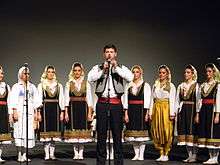Frula
| Classification | |
|---|---|
| Related instruments | |
| see list | |
The frula (pronounced [frǔla], Serbian Cyrillic: фрула), also known as svirala (свирала) or jedinka, is a musical instrument which resembles a medium sized flute, traditionally played in Serbia. It is typically made of wood and has six holes. It is an end-blown aerophone. The frula is a traditional instrument of shepherds, who would play while tending their flocks.
For a list of similar instruments, see the section below.
Names
In Croatia it is commonly known as "jedinka".[1] Other local names in Croatia include žveglica, šaltva, kavela, ćurlik.[2] It has also been simply called "Serbian flute".[3][4]
Overview
The frula is a small wooden flute with six holes.[5] In the Balkans, the frula was played by shepherds while tending their flocks.[5] It is a traditional instrument of Serbia,[6] one of several aerophones used for leisure time, rituals, or accompanying the kolo (circle dance), along with long flutes (duduk, cevara), the double flute (dvojnice), and the bag-pipe (gajde).[7]
Performers

Notable frula players (frulaši) are Adam Milutinović, Sava Jeremić, Tihomir Paunović, Velja Kokorić, Borivoje Todorović, Bora Dugić, Slobodan Vukićević, Spasoje Jović, Andrija and Tomislav Bajić, Radovan Jovanović and others.[8]
Legacy
There are many events dedicated to the frula, such as the Prva pastirska frula in Jagnjilo, Dani Save Jeremića in Ražanj, sabori frulaša in Lelić and Prislonica, takmičenja frulaša in Iđoš, and Frula fest in Kruševac.[8]
A popular Serbian folk song is Ej čija frula[9] ("O, whose frula"), recorded by, among others, Braća Bajić, Radiša Urošević and Cune Gojković.
- Other similar flutes
- shvi, Armenia
- sopilka, Ukraine
- lamzdeliai, Lithuania
- floghera, Greece
- furulya, Hungary
- fujarka, Poland
- kaval, Balkans and Turkey
- balaban or duduk, double-reed, Armenia and Azerbaijan
References
- ↑ Rad kongresa. 1981. p. 334.
- ↑ Danica. Hrvatsko književno društvo sv. Ćirila i Metoda. 1951.
Sviraljka s usnama »jedinka« (svirala, žveglica, šaltva, kavela, ćurlik, to su samo neka njezina lokalna imena)
- ↑ Scribner's Magazine. Charles Scribners Sons. 1922. p. 269.
- ↑ Charles Austin Beard (1930). Toward Civilization. Longmans, Green and Company. p. 275.
- 1 2 Christopher Deliso (2009). Culture and Customs of Serbia and Montenegro. Greenwood Press. p. 140. ISBN 978-0-313-34436-7.
- ↑ Dragoljub Zamurović; Ilja Slani; Madge Phillips-Tomašević (2002). Serbia: life and customs. ULUPUDS. p. 188.
- ↑ Don Michael Randel (2003). The Harvard Dictionary of Music. Harvard University Press. pp. 771–. ISBN 978-0-674-01163-2.
- 1 2 http://www.teklareka.rs/index.php/internauti/item/767-edukativna-radionica-za-zastitu-frulaske-prakse-aj-cija-frula-po-unesku-svira/767-edukativna-radionica-za-zastitu-frulaske-prakse-aj-cija-frula-po-unesku-svira. Missing or empty
|title=(help) - ↑ NIN: nedeljne informativne novine. Politika. 1996. p. 6.
а чувена је она српска пе- сма ових простора „Еј, чија фрула овим шором свира"
- Rastko S. Jakovljević. "Man — Instrument — Sound: Aspects of the Development of Svirala in Serbia" (PDF).
- Silvana Djokić. "Frula a dvojnice v kontextu srbské hudební tradice" (PDF). Bakalářská diplomová práce (in Czech). Masaryk University.
| Wikimedia Commons has media related to Frula. |